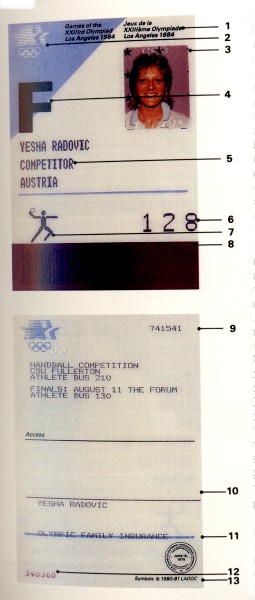Identity Card
Accreditation concepts, goals and requirements Need for accreditation The sole purpose of accreditation was to provide a system of identification for individuals participating in any aspect of the Games. This system was designed to discern their function and therefore, the privileges to which they were entitled. The accreditation system developed by the LAOOC not only identified each individual by name, country and function but detailed each venue that could be entered and when and where the individual was entitled to be seated in a venue. The system further identified an individual's access to special transportation, food, hospitality or accommodations services. The Accreditation Department was formed to organize and implement efficient procedures for the identification and registration of all persons involved in the Olympic Games and for controlling the access of these persons to villages, competition and training venues and other controlled areas. To accomplish this, the Accreditation Department determined the access and site privileges for each member of the Olympic Family, including 8,700 press, 11,000 athletes and officials and over 90,000 support personnel. It then produced the identification badges and developed the computer support systems. The first development and testing of an accreditation system began in late 1982 in preparation for the January 1983 IOC Executive Board meetings in Los Angeles. Design work began on a computer-supported accreditation system that would print badges on demand on various colors of paper stock. Accreditation at the meeting went well, despite frequent malfunctions. It showed at a very early stage that a computer-supported system could work for the Games, but that considerable work in planning and operations would be required. To begin the planning and testing of the computer system, the Accreditation Department hired a full-time director in March 1983. The director was responsible for the development of the system for the LA83 events held that summer. Because the director was hired late, the systems were developed quickly and were not adequately tested during the LA83 events. Accreditation badge elements Several important elements went into the fabrication of every accreditation badge, including: o Personal Identification (PID) number, badge
number and Identity Card (ID) number The following security features were also incorporated into the fabrication of every accreditation badge: o Badge serial number During the pre-Olympic competitions, the Accreditation Department developed operating plans, identified and trained volunteer staff and implemented the actual accreditation and badging process. These LA83 events provided valuable planning and operational experience to the department and formed the basis of the Olympic operation. |

|
Key elements of accreditation badge
1 ldentification (in English and French) of the 2 Star in Motion symbol 3 Photograph of badge holder 4 Letter designating accreditation-type 5 Name, function and country of badge holder 6 Access zone privileges 7 Pictogram for site access 8 Bar code of Personal Identification Number 9 Personal Identification Number (PID) of 10 Signature of badge holder 11 Designation of insurance status of badge holder 12 Badge stock serial number 13 Seal and copyright designation of the LAOOC |
| Separation of accreditation and access privileges
In accordance with the Olympic Charter (1978 Provisional Edition), the LAOOC was required to issue accreditation cards to individuals participating in the Games. The charter specified only the categories "A" - "G" and vaguely identified privileges that were to be granted to persons in these categories. At previous Games, the accreditation badge not only provided identification as required by the charter but provided access to seating and other privileges. The LAOOC decided to separate privileges and access and developed a revolutionary concept that divided the functions of the accreditation badge into two areas: one for identification and one for access. In doing so, the LAOOC fulfilled the charter mandate to provide accreditation, but reserved the right to determine access privileges. A ticket system was developed in support of the accreditation and access
control system whereby eligible Olympic Family members had to obtain complimentary
tickets for selected high-demand events. This helped to reduce the need
for Olympic Family seating at some venues, allowing greater use by the
spectating public. The ticketing system was operated by the LAOOC Ticketing
Department. It required that all members of the Olympic Family (accredited
"A"-"G") use a ticket to attend the Opening and Closing Ceremonies. For
most sports events, tickets were not required for Olympic Family members,
except for athletes ("F") and team officials ("Fo") who were required to
use tickets when attending events at venues other than their own. For preselected
high-demand events, tickets were generally required for Olympic Family
members, except for category "A" (IOC members and guests). Categories of
badges The following accreditation badge categories are mandated by the
Olympic Charter (1978 Provisional Edition): o "A"; IOC members and honorary members, IOC
director and one guest each. (Source Document: Official Report 1984,
Vol. I, page 40) |